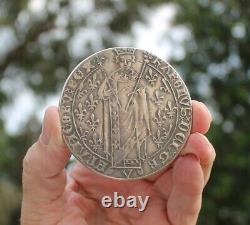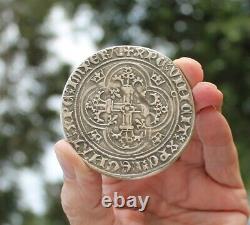CRS, France, medaille, Charles VII, royal d'or, SILVER




This medal is a part of my French medals offer. Visit my page with the offers, please. You will find many interesting items related to this subject. This contemporary SILVER medaille has been minted by the Paris Mint in 1978 to commemorate the royal d'or minted by Charles VII, 1403 - 1461. This medal has been designed and minted in SILVER in 100 pieces only.
This one has the number III/C on the rim. (22 February 1403 - 22 July 1461), called the Victorious. , was a monarch of the. From 1422 to his death.
In 1422, Charles VII inherited the throne of France under desperate circumstances. Duke Philip III of Burgundy. And northern France, including Paris, the most populous city, and.The city in which the French kings were. Had disinherited him in 1420 and recognized. And his heirs as the legitimate successors of the French crown instead. At the same time, a.
Raged in France between the. Diameter - 70 mm, (ca 2¾). Weight - 197.90 gr (6.98 oz). Metal - SILVER, authentic patina.With his court removed to. Charles was disparagingly called the "King of Bourges", because the area around Bourges was one of the few remaining regions left to him. However, his political and military position improved dramatically with the emergence of.
As a spiritual leader in France. Joan of Arc and other charismatic figures led French troops to several important victories that paved the way for the coronation of Charles VII in 1429 at. This long-awaited event boosted French.As hostilities with England resumed. By 1453, the French had expelled the English from all their continental possessions except for the. The last years of Charles VII were marked by conflicts with his turbulent son, the future.
Political conditions in France took a decisive turn in the year 1429 just as the prospects for the Dauphin began to look hopeless. Had been under siege since October 1428. (the uncle of Henry VI), was advancing into the. Ruled by Charles's brother-in-law, René. The French lords and soldiers loyal to Charles were becoming increasingly desperate. But then, in the little village of. , demanded that the garrison commander at Vaucouleurs. Collect the soldiers and resources necessary to bring her to the Dauphin at Chinon. Stating that visions of angels and saints had given her a divine mission. Granted an escort of five veteran soldiers and a letter of referral to Charles by Lord Baudricourt, Joan rode to see Charles at Chinon.She arrived on 23 February 1429. What followed would become famous. When Joan appeared at Chinon, Charles wanted to test her claim to be able to recognise him despite never having seen him, and so he disguised himself as one of his courtiers.
He stood in their midst when Joan entered the chamber in which the court was assembled. She bowed low to him and embraced his knees, declaring God give you a happy life, sweet King!Despite attempts to claim that another man was in fact the king, Charles was eventually forced to admit that he was indeed such. Thereafter Joan referred to him as "Dauphin" or "Noble Dauphin" until he was crowned in Reims four months later. After a private conversation between the two (Charles later stated that Joan knew secrets about him that he had voiced only in silent prayer to God), Charles became inspired and filled with confidence.
After her encounter with Charles in March 1429, Joan of Arc set out to lead the French forces at Orléans. She was aided by skilled commanders such as Étienne de Vignolles, known as. They compelled the English to lift the siege on 8 May 1429, thus turning the tide of the war. On 18 June, at which the English field army lost about half its troops. After pushing further into English and Burgundian-controlled territory, Charles was crowned King Charles VII of France in. Joan was later captured by the Burgundians at the. The Burgundians handed her over to their English allies.By a court composed of pro-English clergy such as Pierre Cauchon, who had long served the English occupation government. She was burned at the stake on 30 May 1431. As important as Joan of Arc in the cause of Charles was the support of the powerful and wealthy family of his wife Marie d'Anjou, particularly his mother-in-law, Queen Yolande of Aragon.
But whatever affection he may have had for his wife, or whatever gratitude he may have felt for the support of her family, the great love of Charles VII's life was his mistress. Charles VII and Philip the Good, Duke of Burgundy, then signed the 1435. Which allowed the Burgundians to return to the side of the French just as things were going badly for their English allies. With this accomplishment, Charles attained the essential goal of ensuring that no. Over the following two decades, the French recaptured Paris from the English and eventually recovered all of France with the exception of the northern port of.
Charles' later years were marked by hostile relations with his heir, Louis, who demanded real power to accompany his position as the Dauphin. Accordingly, Louis stirred up dissent and fomented plots in attempts to destabilise his father's reign. He quarrelled with his father's mistress, Agnès Sorel, and on one occasion drove her with a bared sword into Charles' bed, according to one source.Eventually, in 1446, after Charles' last son, also named Charles, was born, the king banished the Dauphin to the. The two never met again.
Louis thereafter refused the king's demands to return to court, and he eventually fled to the protection of Philip the Good, Duke of Burgundy, in 1456. In 1458, Charles became ill. A sore on his leg an early symptom, perhaps, of. Or another condition refused to heal, and the infection in it caused a serious fever.
The king summoned Louis to him from his exile in Burgundy, but the Dauphin refused to come. He employed astrologers to foretell the exact hour of his father's death.
The king lingered on for the next two and a half years, increasingly ill, but unwilling to die. During this time he also had to deal with the case of his rebellious vassal. Finally, however, there came a point in July 1461 when the king's physicians concluded that Charles would not live past August. Ill and weary, the king became delirious, convinced that he was surrounded by traitors loyal only to his son. Under the pressure of sickness and fever, he went mad. By now another infection in his jaw had caused a tumor or abscess in his mouth. The swelling caused by this became so large that, for the last week of his life, Charles was unable to swallow food or water. Although he asked the Dauphin to come to his deathbed, Louis refused, instead waiting at. In Burgundy, for his father to die. Attended by his younger son, Charles, and aware of his elder son's final betrayal, the King starved to death. He died on 22 July 1461, and was buried, at his request, beside his parents in Saint-Denis. Although Charles VII's legacy is far overshadowed by the deeds and eventual. Of Joan of Arc and his early reign was at times marked by indecisiveness and inaction, he was responsible for successes unprecedented in the history of the Kingdom of France. He succeeded in what four generations of his predecessors failed to do - the expulsion of the English and the conclusion of the.He had created France's first standing army since Roman times. Asserts that if his son.
Had continued this policy, then the French would have become invincible. Charles VII secured himself against papal power by the.
In 1432, and his policies brought some economic prosperity to his subjects. This item is in the category "Coins & Paper Money\Exonumia\Medals". The seller is "rosirenon" and is located in this country: MT. This item can be shipped worldwide.- Composition: Silver
- Country/Region of Manufacture: France

